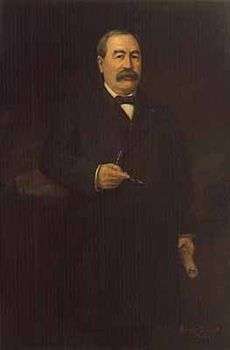Samuel Rinnah Van Sant
| Samuel Rinnah Van Sant | |
|---|---|
|
Samuel Rinnah Van Sant | |
| 15th Governor of Minnesota | |
|
In office January 7, 1901 – January 4, 1905 | |
| Lieutenant |
Lyndon Ambrose Smith Ray W. Jones |
| Preceded by | John Lind |
| Succeeded by | John Albert Johnson |
| 21st Speaker of the Minnesota House of Representatives | |
|
In office 1895–1897 | |
| Preceded by | William E. Lee |
| Succeeded by | John D. Jones |
| Personal details | |
| Born |
May 11, 1844 Rock Island, Illinois, United States |
| Died |
October 3, 1936 (aged 92) Attica, Indiana, United States |
| Political party | Republican |
| Spouse(s) | Ruth Hall |
| Profession | Riverboat captain and boat owner – logging transportation |
| Religion | Methodist |
Samuel Rinnah Van Sant (May 11, 1844 – October 3, 1936) was an American politician who served in the Minnesota House of Representatives and as the 15th Governor of Minnesota.
Early life
Van Sant was born in Rock Island, Illinois to John Wesley Van Sant and Lydia Van Sant (née Anderson). His family had a long history in the shipbuilding industry and his father worked with building and repairing steamboats on the Mississippi River. Van Sant attended school in Rock Island. When the American Civil War began he attempted to enlist but was rejected as too young. After getting written permission from his father, Van Sant was accepted and served with the 9th Regiment Illinois Volunteer Cavalry for three years before being mustered out.[1]
After the war, Van Sant took business classes in Hudson, New York and briefly attended Knox College in Illinois before leaving school due to a lack of money. He worked with his father in the shipbuilding trade and helped develop specialized raft boats for moving lumber along the river. In 1883 he relocated to Winona, Minnesota.[1]
Career
After arriving in Winona, Van Sant continued to work in the shipbuilding and lumber rafting industries. By the 1890s he had become financially successful and his company was responsible for moving more lumber down the Mississippi River than any other.[2]
He also became active with local Republican politics. In 1892 he was elected to the Minnesota House of Representatives and served two consecutive terms from 1893 to 1897. In his second term from 1895 to 1897 he also served as the Speaker of the House.[1][3]
In 1900 he ran for governor against incumbent John Lind and won, serving two terms from 1901 to 1905. As governor Van Sant filed a lawsuit against the Northern Securities Company railroad trust arguing that its formation violated a state law. His case was later taken up at the federal level by President Theodore Roosevelt and, in the 1904 case Northern Securities Co. v. United States, the company was dissolved. He was also involved in legislation which updated the state's election process and removed restrictions on the state legislature's taxation and spending powers.[1][4]
After serving as Governor Van Sant retired from politics. He was commander in chief of the Grand Army of the Republic from 1909 to 1910.[5] He died in 1936 in Attica, Indiana. He is buried in Glendale Cemetery in Le Claire, Iowa.[6]
The Samuel Van Sant House in Le Claire, Iowa is listed on the National Register of Historic Places.
References
- 1 2 3 4 White, J. T. (1906). The National Cyclopaedia of American Biography. p. 325.
- ↑ Larson, Agnes Mathilda (1949). The White Pine Industry in Minnesota: A History. University of Minnesota Press. p. 95. ISBN 9781452913582.
- ↑ "Van Sant, Samuel Rinnah — Legislator Record". Minnesota Legislative Reference Library.
- ↑ Risjord, Norman K. (2008). A Popular History of Minnesota. Minnesota Historical Society.
- ↑ "Samuel Rinnah Van Sant". National Governors Association.
- ↑ "Samuel Rinnah Van Sant (1844-1936)". Find A Grave.
External links
- Biographical information and his gubernatorial records are available for research use at the Minnesota Historical Society.
| Political offices | ||
|---|---|---|
| Preceded by John Lind |
Governor of Minnesota 1901 – 1905 |
Succeeded by John Albert Johnson |
| Preceded by William E. Lee |
Speaker of the Minnesota House of Representatives 1895 – 1897 |
Succeeded by John D. Jones |
| ||||||||||||
|


